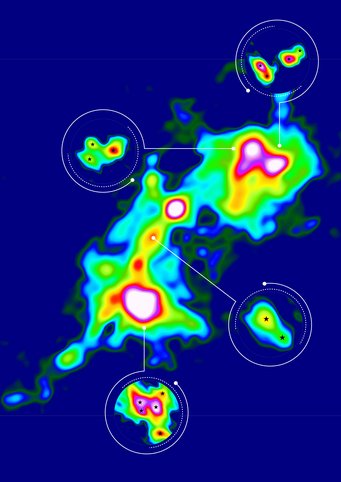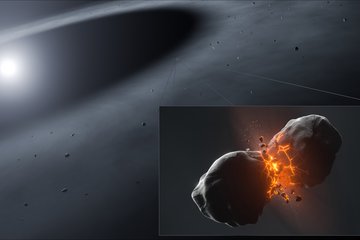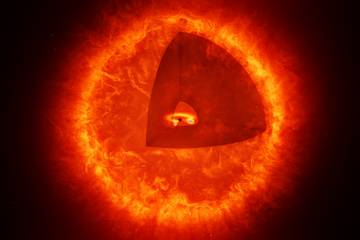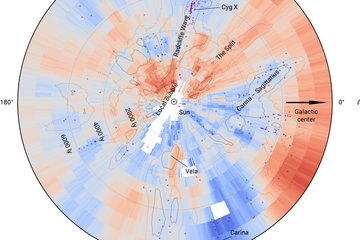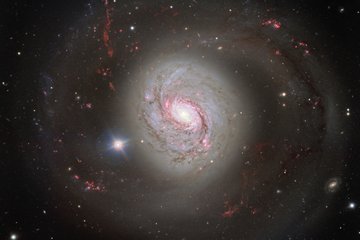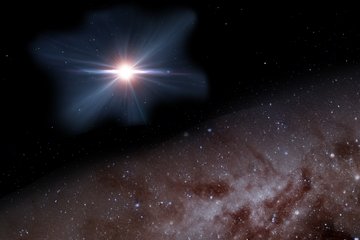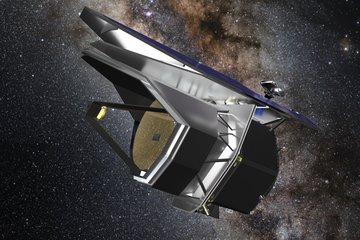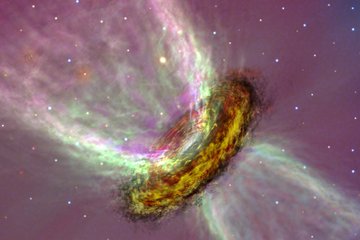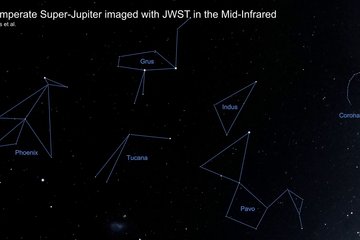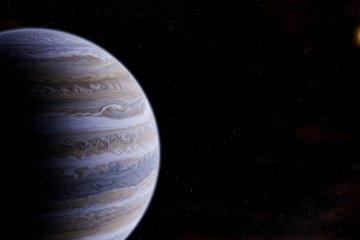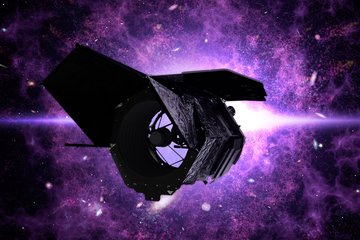Twins, Triplets, Quadruplets and more: Observations show massive stars are indeed born as multiples
Massive stars have long been thought to be born as twins, triplets or higher multiples. But so far, there was little observational evidence confirmation for the multiplicity of massive star births. This has changed with the observations presented here: a detailed study using the ALMA radio observatory that found four binary proto-stars, one triple, one quadruple and one quintuple system in one massive star cluster. The new results, which have been published in Nature Astronomy, confirm our current understanding of the formation of massive stars: such stars are indeed born as multiples.
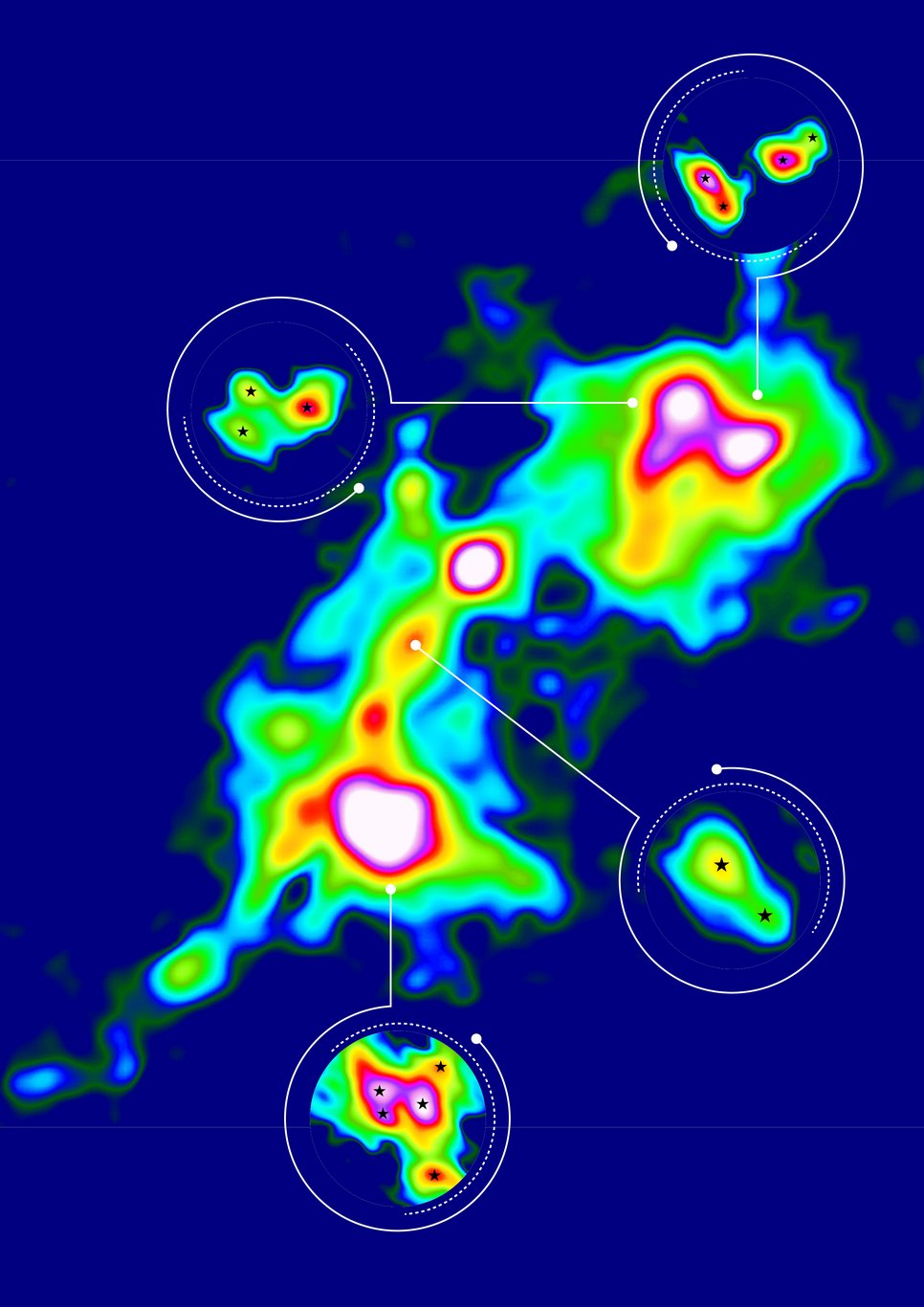
In human newborns, multiples are rare. Typically, less than 2% of all births involve multiples, mostly twins. For massive stars, on the other hand, multiple birth has long thought to be the norm. That was shown by simulations which traced the collapse of giant clouds of gas and dust from the beginnings to the formation of separate stars within: a hierarchical process in which larger cloud portions contract to form denser cores, and where smaller regions within those "parent cores" collapse to form the separate stars: massive stars, but also numerous less massive stars. In fact, our Sun formed as a low-mass proto-star in such a massive star cluster.
Massive stars, which have more than about eight times the mass of our Sun, are of particular interest to astronomers: These are the stars that form neutron stars and black holes, including the black holes that merge and emit copious amounts of gravitational waves. Also, massive stars are very bright, up to a million times as bright as our Sun, so these are the stars we see in other galaxies.
Until now, although there was a good theoretical understanding of star formation under those circumstances, key evidence was missing: It is very difficult to observe star formation regions in sufficient detail. Observations had, up to that point, been able to show only a few candidates for isolated multiples in massive star clusters, but nothing like the teeming crowd of multiples predicted by the simulations.
Pointing ALMA at a massive star cluster
In order to confirm or rule out the current models of massive star formation, it was clear that more detailed observations were needed. This became possible once the ALMA observatory in Chile became operational. In its present form, ALMA combines up to 66 radio antennae to act as a single gigantic radio telescope, allowing radio observations that show exquisitely small details. Led by Patricio Sanhueza of the Japanese National Observatory NAOJ and the Graduate University for Advanced Studies in Tokyo, and including several researchers from the Max Planck Institute for Astronomy (MPIA) in Heidelberg, a group of astronomers set out to observe 30 promising massive star-formation regions with ALMA between 2016 and 2019.
Analyzing the data proved a considerable challenge, and took several years. Each separate observation yields around 800 GB of data, and reconstructing images from the contributions of all the different antennae is a complex process. The result that has now been published is based on the analysis of one of the star-formation regions, which has the catalogue number G333.23–0.06. The analysis was led by MPIA’s Shanghuo Li, who is also the lead author of the resulting paper that has now been published in Nature Astronomy. The resulting reconstructed images are remarkable: They show details down to about two hundred astronomical units (200 times the Earth-Sun distance) for a large region around 200,000 astronomical units across.
Multiples on display
The results are excellent news for the current picture of massive star formation. In G333.23–0.06, Li and his colleagues found four binary proto-stars, one triple, one quadruple and one quintuple system – consistent with the expectations. In fact, the observations of the environments bolster a particular scenario for high-mass star-formation: They provide evidence for hierarchical star formation, where the gas cloud first fragments into "cores" of increased gas density, and where each core then fragments into a multiple proto-star system.
Henrik Beuther, who leads the Star Formation group in the Planet and Star Formation department at the Max Planck Institute for Astronomy, says: "Finally, we were able to take a detailed look at the rich array of multiple star systems in a massive star formation region! Particularly exciting is that the observations go as far as to provide evidence for a specific scenario for high-mass star formation."
Shanghuo Li, an astronomer at the Max Planck Institute for Astronomy and the current publication’s lead author, adds: “Our observations seem to indicate that when the cloud collapses, the multiples form very early on. But is that really the case? Analyses of additional star formation regions, some of them younger than G333.23–0.06, should give us the answer.” Specifically, the astronomers are currently working on a similar analysis for the additional 29 massive star formation regions they had observed – soon to be joined by 20 more, with new ALMA observations led by Li. That should allow farther-reaching statistics on the properties of such regions, and insight into the evolution of the multiples. But even with the present results, the role of multiples in massive star formation is now firmly anchored in observation.
Background information
The work described here has been published as Shanghuo Li et al., “Observations of high-order multiplicity in a high-mass stellar protocluster” in the journal Nature Astronomy.
Journalists who would like a copy of the refereed paper should please contact the Nature press office at press@nature.com.
The MPIA researchers involved are Shanghuo Li, Henrik Beuther and Thomas Henning, in collaboration with colleagues from the National Astronomical Observatory of Japan, National Institutes of Natural Sciences, Tokyo, Japan; the Department of Astronomical Science, School of Physical Science, SOKENDAI (The Graduate University for Advanced Studies), Tokyo, Japan; the Institute of Astronomy and Department of Physics, National Tsing Hua University, Hsinchu, Taiwan; the Faculty of Physics, University of Duisburg-Essen, Duisburg, Germany; the Origins Institute and Department of Physics and Astronomy, McMaster University, Hamilton, Ontario, Canada; the Department of Earth, Environment, and Physics, Worcester State University, Worcester, MA, USA; the Center for Astrophysics, Harvard & Smithsonian, Cambridge, MA, USA; the Shanghai Astronomical Observatory, Chinese Academy of Sciences, Shanghai, People’s Republic of China; the Heidelberg Institute for Theoretical Studies, Heidelberg, Germany; the Graduate School of Informatics and Engineering, The University of Electro-Communications, Tokyo, Japan; and the School of Astronomy and Space Science, Nanjing University, People’s Republic of China.
The Atacama Large Millimeter/submillimeter Array (ALMA), an international astronomy facility, is a partnership of ESO, the U.S. National Science Foundation (NSF) and the National Institutes of Natural Sciences (NINS) of Japan in cooperation with the Republic of Chile. ALMA is funded by ESO on behalf of its Member States, by NSF in cooperation with the National Research Council of Canada (NRC) and the National Science Council of Taiwan (NSC) and by NINS in cooperation with the Academia Sinica (AS) in Taiwan and the Korea Astronomy and Space Science Institute (KASI). ALMA construction and operations are led by ESO on behalf of its Member States; by the National Radio Astronomy Observatory (NRAO), managed by Associated Universities, Inc. (AUI), on behalf of North America; and by the National Astronomical Observatory of Japan (NAOJ) on behalf of East Asia. The Joint ALMA Observatory (JAO) provides the unified leadership and management of the construction, commissioning and operation of ALMA.
MP
